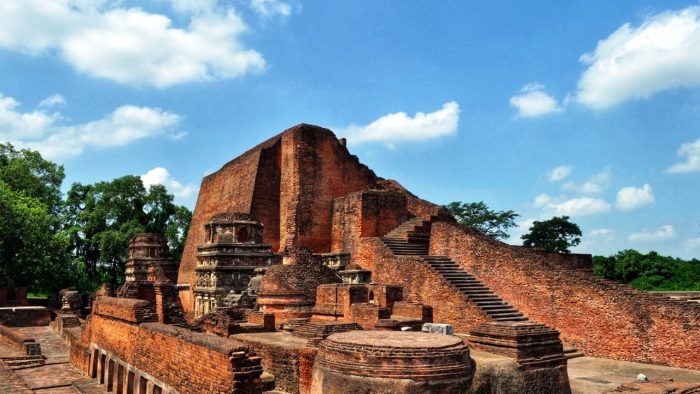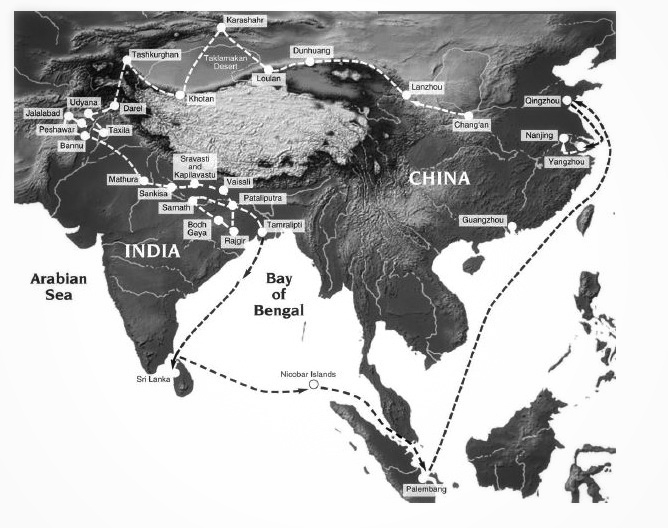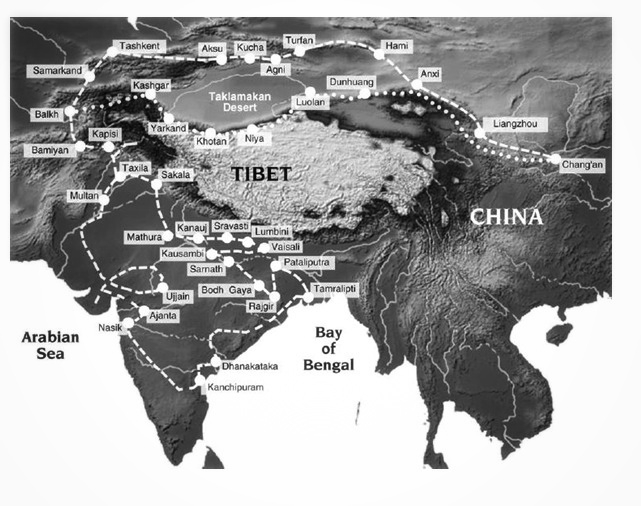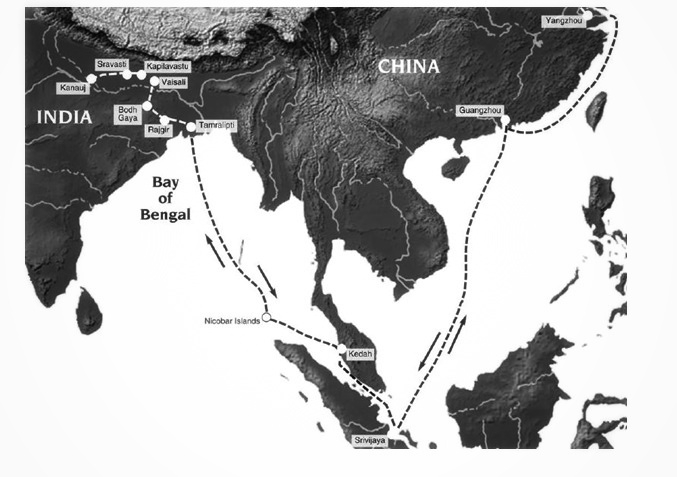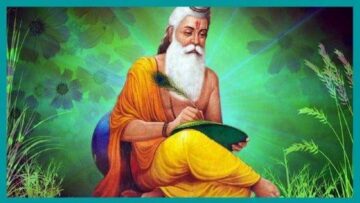ABSTRACT
In 7th century C.E, Chinese traveler XuanZang got the fortune to interact with 300 plus scholars from Silon in Kanchipuram. He exchanged philosophical thoughts with them and tested the depth and vastness of their knowledge in various philosophy subjects.
The topic of discussion was mainly on ancient art and science of Yoga. XuanZang clearly understood that the scholars from Silon lacked the intellectual profoundness of Śīlabhadra, monk and philosopher from Nalanda. XuanZang, being the one who studied in Nalanda for two years has noted in detail about Nalandha, one of India’s oldest and greatest University.
Xuanzang travelled from China to Nalanda in search of knowledge was lucky enough to be trained under the guidance of Śīlabhadra. Before XuanZang it was Faxian who travelled from China to India with an imply to learn the rich philosophical thoughts from India.
It was Faxian’s luxuriant note on India which helped Chinese travelers to travel across mountains to reach India for learning. XuanZang followed by Yijing recorded that, in Nalanda apart from Chinese students, there were students from Japan and Korea as inmates.
While exploring Chinese travelers it is quite evident that, they visited Nalanda in search of Knowledge from a great Indian University. The ancient travelers who have travelled to Nalanda from different foreign countries other than China, Korea and Japan would have had the same intension.
To learn and understand the great Indian philosophies! Was that the same with other travelers who have been to Nalanda? This question need to be answered only after deeper research into the work of other travelers.
In the Muslim chronical Tabaqat–i-Nasiri of Minhaj-i-Siraj it is noted exactly as follow:
“He [Bakhtiyar Khalji] used to carry his depredations into those parts and that country until he organized an attack upon the fortified city of Bihar.” Are we seeing a drastic change in the intentions of the travelers? World’s image of Nalanda has a long history.
This paper check the connotations of various travelers by carefully understanding the documents of Faxian, XuanZang, Yijing and Minhaj-i-siraj.
This study is an attempt to peek into the travelogue of ancient travelers to excavate the details of the great Indian University, Nalandha.
Introduction
Dwijendra Narayan Jha, a former member of the Indian Council of Historical Research has come up with an instructing argument in his new book, ‘Against the Grain: Notes on Identity, Intolerance and History’.
Jha, wrote on Nalanda that it’s library was set on fire by “Hindu fanatics”. “The popular view, however, wrongly attributes this conflagration to the Mamluk commander Bakhtiyar Khilji, who never went there, but, in fact, sacked the nearby Odantapuri Mahavihara at modern-day Bihar Sharif” 17 .
This paper examines the above statement by DN Jha on Nalanda Mahavihara and the factors related to its destruction.
The ruins of the monastic establishments of Nalanda have been identified beyond any scope of doubt as the site of the Nalanda Mahavihara, once the cynosure of the academic world as the greatest center of Buddhist learning ” 1 notes in thesis of Chandra Shekhar Prasad.
In order to have a proper understanding of Nalanda Mahavihara, and to find out what was present in Nalanda before it was destroyed, we need to trace back to 1500 years of history. On the course of finding the history, this paper will also explore the travel documents by various travelers to Nalanda from 3 C.E (Common Era).
Course of learning about Nalanda raises at least three difficult questions. (1) How is it important to document the travel logue and history of the places we visit? (2) Who destroyed Nalanda? (3) What was the intension behind destroying a great Indian University?
This paper aims to find out the truth by following the travel records by Faxian, XuanZang, Yijing, Minhaj-i-siraj and Chaglo-Tsaba Chos rje-dpal Aka Dharmasvamin.
Let us examine the travelogues of foreign travelers and try to address the above mentioned questions. Since the beginning of understanding the history of Magadha kingdom, the travel accounts preserved have formed a very valuable source of information.
Travel Records of Chinese Pilgrim Fa-xian
Indo-China cultural and philosophical exchange flourished from the 4th Century and till the mid of 13th century. Duni Chand’s thesis serve as the best authority to the above stated assessment, “With the fall of the extensive and centralised Han Empire in 3rd century A.D., the relations between India and China lost its smoothness for some time.
Official relations between India and China began to revive at the close of the 4th century A.D”2.
The Chinese monk Fa-Hien’s parents wanted their son to be a Buddhist monk, and is believed to be the first prominent traveler who visited India11. Fa-Xian, who had had been living in Ch’ang-gan started his journey and reached the emporium of Chang-yih.
When he was in Ch’ang-gan “He entered into an engagement with Hwuy-king, Tao-Ching, Hwuy-ying and Hwuy-wei that they should go to India and seek for the disciplinary rules”12, snice the books of discipline available with them was imperfect.
Fa-Xian undertook a visit to India in search of better copies of Buddhist books than were presently obtainable in China. Started from Chang-yih they reached T’un-hwang then to Lou-lan, were he notes that the place had nearly four-thousand monks.
Many days of journey from this to the east brought the travelers to the kingdom of Taxila. Fa-Hien’s time embraced a large area starting from Udyana, north of the Punjab till Tamralipti, located on the Bay of Bengal, strongholds of good monasteries. He noticed in Udyana alone no less than 500 monasteries inhabited by monks of the Hinayana school.
Fa-Hien notes the social condition in India as prosperous and people were content with their lives. But he dint detail on the political condition and administration details. Even though he has travelled through Pataliputra, there is no mention of Nalandha University as such.
Fa-Hien took many years for his complete travel from China to Central India, in a journey full of physical hazards and trouble.
He noted in his memoirs:
“When I look back on what I have gone through, my heart is involuntarily moved, and the perspiration flows forth. That I encountered danger and trod the most perilous places, without thinking of or sparing myself was because I had a definite aim, and thought of nothing but to do my best in my simplicity and straightforwardness.
Thus it was that I exposed my life where death seemed inevitable if I might achieve a ten-thousandth part of what I had hoped.”
Fa-Hien’s account brings us into touch with Buddhist India, the main hub of Chinese learning.He returned to China in 415 C.E via the port of Tamralipti situated near the Ganges delta.
Travel Records of Chinese Pilgrim Xuanzang
The Chinese Pilgrim Xuanzang (Huan-Tsang) came to India during Harsha Vardhan’s period. Xuanzang, who left behind detailed accounts, note only promoted India’s rich philosophical doctrines but also tried to foster diplomatic exchange between china and India.
Xuanzang started his pilgrimage to India without formal authorization from the Tang court, as Tang China and Gokturks were at war at that time. He reached Turpan in 630 C.E. Moving further in a westerly direction he reached Karasahr, moved further west to Samarkand.
He reached Adinapur, in Yin-tu were he meet Buddhist monks. “The pilgrim having now arrived at the frontiers of the great country which he calls Yin-tu (India) gives his readers a “Ksgah-sight” of the land before taking them through its various kingdoms”.
His journey included, passing through Khyber Pass, reaching the former capital of Gandhara, Peshawar. “He followed the northern branch of the Silk Road round the Taklimakan on his outward journey, and he returned to the Tang capital at Xian via the southern route. He is still seen by the Chinese as an important influence in the development of Buddhism in China and his travels were dramatized by in the popular classic “Tales of a journey to the West”.
Xuanzang set of from Lumbini in 637 C.E to Kusinagara, the place of Buddha’s death, moving eastward, at first via Varanasi, Xuanzang reached Vaisali, Pataliputra and Bodh Gaya. Local monks accompanied him to Nalanda.
Xuanzang’s arrival period to Nalanda is at a time when China had taken deep root interest in Indian Monastic institutions and doctrines. “Hiuen Tsang tells us that sanaka a dark red cloth made of the fibre of the sanaka plant (a kind of hemp) was used by the bhiksus “.
According to the accounts of Xuanzang, Nalanda had as many as 8,500 students and 1,500 teachers. According to the accounts of Xuanzang, a wide range of subjects were taught in Nalanda,it was the best education available at that time.
Xuanzang who studied there for five years, studied Yoga shastra under Silabhadra.He also studied Nyaya, Hetuvidya, Shabdavidya and the Sanskrit grammar of Panini.
Other Monasteries seen by Xuanzang includes Bamian, Kapis, Lampa, Nagarkot, Gandhara, Paiusha, Udyana, Bolor, Taxila, Hayamukha, Magadha. He had the fortune to visit Chola Country. At the time of Xuanzang’s visit 300 bhikshus of ceylon also reached Chola capital.
Xuanzang meet these Bhikshus and told his future intention to visit Ceylon for to learn Scriptures. Bhikshus told him that there were no brethren there superior to them.
Then the Bhikshus discussed some yoga texts with Xuanzang and he found that their explanation could not excel those given to him by Silabhadra of Nalanda.
Xuanzang’s account also “goes to show to what extent hospitality and tourism flourished in India of his time. We owe a lot to this Buddhist traveler for his unbiased accounts of social, political history of all the lands he visited”.
Travel Records of Chinese Pilgrim Yijing
“The mission of Yijing(I-tsing) was mainly the study of the vinaya rules and the observance of those rules by the Indian monks”[6]. Yijing set -off his trip to India in 671 C.E and went back to China in 695 C.E. “I-tsing, was in the Western Capital (Ch’ang-an) in the first year of the Hsien-heng period (670), studying and hearing lectures.
At that time there were with me Ch’u-i, a teacher of the Law, of Ping-pu ; Hung-i, a teacher of the Sastra, of Lai-chou , and also two or three other Bhadantas ; we all made an agreement together to visit die Vulture Peak (Gr/dhraku/a), and set our hearts on (seeing) the Tree of Knowledge (Bodhidruma) in India[14] “.
Even though Yijing’s account is very less in content but he too has left a touching account of the love of learning in Nalanda. According to Yijing, in a day minimum of 100 lectures were held at Nalanda.
According to Yijing, Nalanda was also famous for its well-equipped big library with three huge buildings called Ratnasagara, Ratnadadhi and Ratnaranjaka of which Ratnasagara was a nine-storeyed building.
All the libraries stored rare sacred manuscripts. Yijing, accounts of having collected 400 different texts and 500,000 shlokas from India. Collecting scriptures from India and carrying to China for propagation was considers as a great holy duty by many scholars.
“Yijing (I-tsing) writes that he visited the monastery Bha – ra – ha or Barahat or Varaha at Tamralipti(modem Tamluk and adjoining areas in the Midnapur district)”7.
Yijing through his records provided the followers of Buddhist doctrine in China to envision a journey to India. He notes “If you read this Record of mine, you may, without moving one step, travel in all the five countries of India.”[14].
These travel accounts details us the difficult journeys of Chinese seekers by foot and on board ships just to imbibe knowledge from Indian professors.
Travel Records of Khilji dynasty
The history of India from the first half of 12th century has been reconstructed mainly from the accounts of Muslim records. Tabaqat-i Nasiri, written in Persian by Minhaj-i-Siraj Juzjani is a detail account of to account for the Muslim dynasties that started in Iran and Central Asia.
“Tabaqat-i-Nasiri deals with the early Muslim rulers of Central Asia, extension of their rule in India – from Md. Ghori to Sultan Nasiruddin of the slave dynasty” 8.
Tabaqat–i-Nasiri, account mentions the attack of Muhammad bin Bakhtiyar Khalji on Bihar.”He led a force towards Bihar, and ravaged that territory. He used to carry his depredations into those parts and that country until he organized an attack upon the fortified city of Bihar.
Trustworthy persons have related on this wise, that he advanced to the gateway of the fortress of Bihar with two hundred horsemen in defensive armour, and suddenly attacked the place “15. It also noted that the greater number of inhabitants of fortified city of Bihar are clean shaven Brahmans.
As per the view of Jadunath Sarkar, the high priest of communal historiography in India “The above account mentions the fortress of Bihar as the target of Khalji’s attack. The fortified monastery which Bakhtiyar captured was ‘known as Audand-Bihar or Odandapura-vihara’(Odantapuri ) “16 .
Odandapura-vihara (Odantapuri ), a Buddhist Mahavihara located not too far from Nalanda. This attack by Khalji destroyed Odandapura-vihara and he killed all the inhabitants and burned it completely. We can also notice the concept of ‘Holy war’ from the account of Minhaj-i-Siraj where Khalji and his men were leading plundering expeditions in Bihar over infidels. Holy war was not limited to Bihar, it was a common scene in other parts of India as well.
“Till the 18th century the Buddhists were practically displaced from the soil of Bengal due to the destructive strategy adopted by the Muslim rulers” 10.
Conclusion
Travel Records of Tibetan monk Chaglo-Tsaba Chos rje-dpal (Dharmasvamin), mentions that he found a small class still conducted in the ruins of Nalanda by a 90 old monk, Sribhadra.
Dharmaswamin visited Nalanda in 1235, after forty years of its sack.The old monk was taken care by a local Brahmin, Javadeva. When a group of 300 Turks again came for ethnic cleansing Dharmaswamin carried Shibhadra on his back and took the surviving manuscripts under his robe and made their exit from India 19.
This account of Dhamaswamin shed light on the Brahmin – Buddhist relation and the Turkish hate on the infidels. But sadly D N Jha fails to see such reality, and argues that Nalanda was set on fire by “Hindu fanatics”.
This argument is against the reality that “The Indian subcontinent has been the homeland of many religions and sects that have flourished independently as well as influenced one another.
In ancient Bihar too, a similar situation prevailed with religions like Buddhism, Jainism and the Brahmanical faith flourishing in a social atmosphere of mutual tolerance and respect.” [9]
An expert from the book ‘History Of Magadha’ states “The Buddhism Of Magadha was finally swept away by the Mughal invasion under Bakhtiyar Khilji, In 1197 the capital Bihar was seized by a two hundred horsemen,who rushed the postern gate, and sacked the town. [18]”. Both the universities, Odantapuri and Nalandha situated in Maghada.
Tibetan records says there were about 12,000 students at Odantapuri. Dr N Jha’s book ‘Against the grain notes on identity intolerance and history’ is, as usual a leftist polemics, an effort in misdirection. The evidences belonging to the past of Nalanda points to the fact that it was destroyed by warriors for Islam.
References
- Chandra Shekhar Prasad, Nalanda vis-a-vis the Birthplace of Sariputra , The Istituto Italiano per l’Africa e l’Oriente (IsIAO) in 2015.
- Duni Chand, Sino Indian relations in the post cold war era, Himachal Pradesh University, 2016.
- Marylin M. Rhie, ‘Aspects of the two Colossal Budhas at Bamiyan’ ,Indira Gandhi National Centre for the Arts, New Delhi, January 17-19, 2003, pp.2-3.
- Bhagaban Goswami, Pragjyotishpur the capital of the kamarupa rulers through the ages till 11th century AD as depicted in literature, Gauhati University, 2008.
- P Premkanna, Role of hospitality industry in promoting tourism in India, Madurai Kamraj University, 2015.
- Kshanika Saha, Buddhism and Buddhist literature in central Asia, University of Culcutta, 1966.
- Krishnendu Ray, Socio economic background of religious institutions and establishments in eastern India during early medieval times AD 600 AD 1200, University of Calcutta, 2002.
- Nasrin Jahan, A study of pre Moghul histories written in Persian prose in India 1206 1388 A D, University of Calcutta, 1978.
- Nilkamal Choudhary, A cultural history of Nalanda C 400 A D C 900 A D, 1990.
- Saswati Dasgupta, Buddhist studies and culture in West Bengal, 2007.
- K.C Khanna, As They Saw India, 7th Edition, 2015.
- A Record of Buddhist Kingdoms Being As Account By The Chinese Monk Fa-Hien Of His Travels In India And Ceylon by James Legge, The Clarendon Press, 1886.
- Thomas Watters M.R.A.S. On Yuan Chwang’s Travels in India, 629-645 A.D. Vol.1, London Royal Asiatic Society, 1904.
- Junjiro Takakusu, A Record of Buddhist Practices Sent Home from the Southern Sea, 1896.
- Tabaqat-i-Nasiri, Translated from Persian by Major H.G Raverty, 1873.
- History of Bengal, vol. 2, Dacca, 1948.
- Dwijendra Narayan Jha, Against the Grain: Notes on Identity, Intolerance and History, 2018.
- L.L.S Omalley and J.F.W James, History of Magadha.
- Dr A S Altekar , Biography of Dharmasvamin, 1959
(This paper was presented by Sooraj Rajendran at Indic Yatra conference)
Disclaimer: The opinions expressed in this article belong to the author. Indic Today is neither responsible nor liable for the accuracy, completeness, suitability, or validity of any information in the article.

